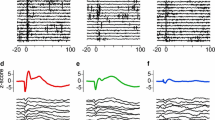Abstract.
Physiological mapping of the body representation 1 month or longer after forelimb removal in adult rats revealed new pockets of shoulder representation in the forepaw barrel subfield (FBS) in the first somatosensory cortex (SI). These "new" shoulder representations have longer evoked response latencies than sites in the shoulder representation within the trunk subfield, hereafter referred to as the "original" shoulder representation. We postulated that the "new" shoulder representations in the FBS were relayed from the "original" shoulder representation. We investigated this hypothesis by studying anatomical connectivity between the "original" shoulder representation and the FBS in intact control and forelimb deafferented adult rats using Phaseolus vulgaris leucoagglutinin (PHA-L), biocytin, and biotin dextran-amine (BDA) as anterograde tracers. The retrograde tracer cholera toxin beta subunit (CT-B) injected into the FBS was also used to study connectivity between the "original" shoulder representation and the FBS. Using these anatomical tracing techniques, we were unable to show the existence of a direct corticocortical connection between the "original" shoulder representation in the trunk subfield and the FBS in either intact or deafferented rats. Functional connectivity between the two cortical regions was studied by ablating the "original" shoulder representation alone or in combination with the shoulder representation in the second somatosensory cortex (SII) while recording evoked responses in the FBS following electrical stimulation of the shoulder. Both ablations failed to eliminate the evoked responses at the "new" shoulder sites in the FBS, suggesting that SI and SII are not necessary for "new" shoulder input in the FBS. It is suggested that subcortical sites may play a major role in large-scale cortical reorganization. Results of projections from the "original" shoulder representation to parietal medial (PM), parietal lateral (PL), SII, parietal ventral (PV), and parietal rhinal (PR) sensory fields and agranular lateral (AgL) and agranular medial (AgM) motor fields are also described.
Similar content being viewed by others
Author information
Authors and Affiliations
Additional information
Electronic Publication
Rights and permissions
About this article
Cite this article
Pearson, P., Arnold, P., Oladehin, A. et al. Large-scale cortical reorganization following forelimb deafferentation in rat does not involve plasticity of intracortical connections. Exp Brain Res 138, 8–25 (2001). https://doi.org/10.1007/s002210100678
Received:
Accepted:
Issue Date:
DOI: https://doi.org/10.1007/s002210100678




